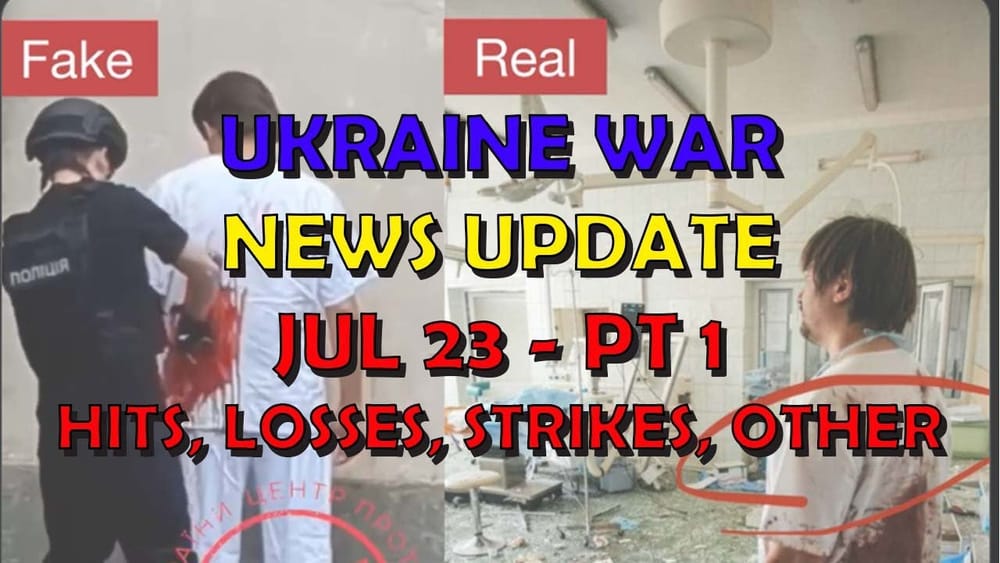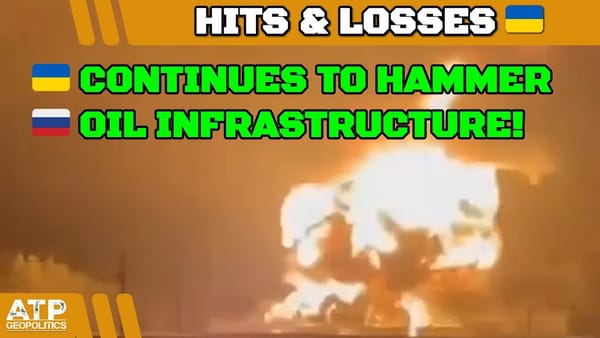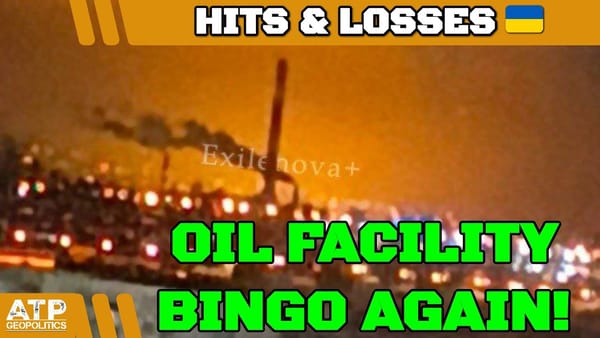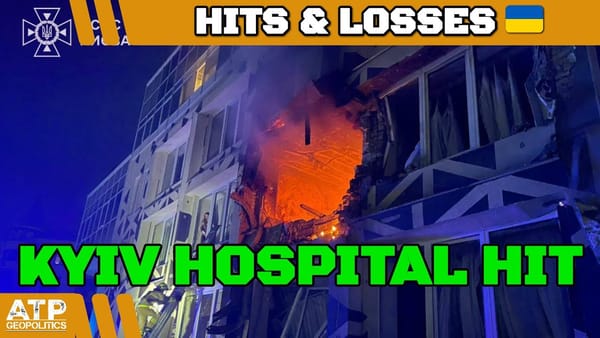Ukraine War Update NEWS: Pt 1 - Overnight & Other News
🤖
This summary has been produced automatically by an AI Large Language Model (LLM) without any human intervention. Whilst every effort has been made to prompt the LLM to produce accurate output, there may be inconsistencies, inaccuracies or hallucinations!
Table of Contents 📖
"It's like betting on horses, you don't bet that a horse will win if it's lost a thousand times in a row, right? So we've found out a thousand times in a row that Russia have lied, then... the probability is you're going to be lying the next time. And if you're not lying, then you've done yourself a disservice by lying all those other times."
Hello Team
🎦 00:00-00:13⏩
Jonathan welcomes viewers to another ATPG video, a Ukraine War News Update for 23 July 2024.
Return to top⤴️
🪦 DISCLAIMER FOR GENERAL STAFF LOSSES DATA
- These are real people with real lives and real families who love them. Don’t let the numbers sap your humanity.
- These numbers probably aren’t accurate but they’re the best we have and we don’t need them to be accurate to be indicative of patterns of activity.
- All losses are estimates. Losses cannot be counted with accuracy because of the conditions on the ground.
- Both sides would see it to be of their advantage to minimize their own losses maximize the other side’s losses.
- Neither side releases their losses but we have enough transparency from the Ukrainian side to have confidence in they are indicative.
- Personnel losses are hard to count. If a soldier gets injured, heals up, and returns to the front line only to get injured again, is that one loss or two? Also, how to deal with losses from PMC’s or soldiers fighting with RF from occupied territories?
- Equipment losses are hard to count. If an AA complex involves several parts and one part gets disabled, is that a loss, or a fraction of a loss? If a tank gets disabled, repaired, back into the fight, then disabled again, is that one lost tank or two?
- All recorded losses are vulnerable to multiple reporting. We have already seen numerous cases of multiple drones in the air reporting the same loss from different angles as multiple engagements.
- Losses are not always reported on the same day they occurred. It is frequent that drone losses are reported at least 24 hours after other terrestrial equipment losses. Certain losses may not be reported for days or weeks for military intelligence reasons.
Ukrainian General Staff report on Russian losses
🎦 00:13-01:50⏩
- Jonathan reviews the daily Ukrainian General Staff figures for Russian losses, noting an increase in personnel lost (1,220) but a decrease in tank losses (4).
- He observes the variability in Russian equipment losses over the past few weeks.
- He highlights significant losses in artillery systems (57), armoured personnel vehicles (20), and fuel tanks (64) as notable.
- Jonathan cites the UK Ministry of Defence assessment that Russian casualties in May and June 2024 averaged over 1,000 per day - the highest rate since the start of the war - due to poorly trained troops being used to overwhelm Ukrainian defenses.
- He analyses the figures, suggesting that while Russia is making territorial gains, the cost in manpower is high. He speculates that they may not be using combined arms tactics effectively and could be facing artillery ammunition shortages.
HIMARS strike on Russian Yastreb counter-battery radar system
🎦 03:33-06:15⏩
- Jonathan analyses footage of a HIMARS strike on a Russian Yastreb counter-battery radar system. He emphasises that this is a costly loss for Russia ($250 million according to online sources) and not easily replaceable.
- He contrasts this with Ukraine's ability to receive military aid from allies, citing the example of Lithuania providing advanced radar systems.
- He sees this loss as indicative of the overall degradation of Russian military capabilities.
HIMARS strike on Russian Tor air defence system
🎦 06:20-07:07⏩
- Jonathan reviews another video showing a Ukrainian reconnaissance drone tracking a Russian Tor air defence system before a HIMARS strike destroys it.
- He highlights Russia's lack of counter-drone capabilities, noting the effectiveness of medium-range reconnaissance drones operating behind Russian lines.
Analysis of Russia deploying M46 howitzers
🎦 07:07-10:01⏩
- Jonathan discusses Russia's deployment of older M46 howitzers, acknowledging a user comment (Jompie) suggesting this might not be as dire a situation as it seems.
- Jompie argues that the M46s, while old, are still effective and have good range. Their deployment could indicate that Russia has secured a reliable ammunition source (possibly from North Korea).
- Jonathan acknowledges this viewpoint but maintains his position that deploying older howitzers suggests equipment shortages and reflects poorly on Russia's military situation.
- He cites further user comments noting the poor state of some Russian artillery pieces lacking tyres, highlighting further logistical issues.
Russian soldier's social media post reveals equipment shortages
🎦 10:01-12:26⏩
- Jonathan highlights a social media post shared by defence analyst Andrew Perpetua from a Russian soldier complaining about inadequate equipment, specifically anti-drone systems, forcing them to rely on shotguns and crowdfunding.
- He links this to the wider issue of Russia's struggles with Ukrainian drones and the effectiveness of electronic warfare. He speculates that Russia's initial advantage in electronic warfare has been eroded over time.
- Jonathan emphasises the asymmetry in electronic warfare and drone capabilities, suggesting Ukrainian forces are increasingly able to overcome Russian electronic countermeasures due to having access to superior technology.
Ukrainian artillery ammunition shortages
🎦 12:26-14:45⏩
- Jonathan acknowledges Ukraine's ongoing shortage of artillery ammunition, despite receiving 50,000 shells from a Czech initiative.
- He quotes Andrew Perpetua, who notes that many areas of the frontline are defensible for Ukraine but ammunition shortages prevent them from capitalising on this.
- Jonathan discusses the implications of these shortages, citing Perpetua's observations of desperate Russian "YOLO" (You Only Live Once) attacks that succeed due to Ukraine's inability to respond with sufficient artillery fire.
- Jonathan speculates that Ukraine is facing similar shortages of MANPADs (Man-Portable Air Defence Systems) and ATGMs (Anti-Tank Guided Missiles) based on the decreased reporting of their use.
Russian "YOLO" attacks and impact on mapping the frontline
🎦 14:49-15:45⏩
- Jonathan returns to the topic of Russian "YOLO" attacks, where small units make rapid advances into unexpected positions despite the high risk of being cut off.
- He notes that these attacks, while often resulting in heavy Russian casualties, can lead to territorial gains that are difficult to reverse and complicate efforts to accurately map the front lines.
- He mentions that he's behind on updating his own frontline maps due to the frequency of these small-scale advances.
Drone and missile attack on Sumy region
🎦 15:45-16:00⏩
- Jonathan reports on an overnight attack on Ukraine's Sumy region involving eight drones and one KH-69 air missile.
- He notes that Ukrainian air defences shot down seven of the eight drones, with the missile also missing its target.
Drone attack on a ferry in the Kerch Strait
🎦 16:16-18:16⏩
- Jonathan reports on a drone attack on a ferry in the Kerch Strait, citing Russian sources that claimed the vessel caught fire.
- He notes that this is not the first attack on ferries in the Kerch Strait and speculates that the targeted vessel might have been a railway ferry.
- He explains the significance of these attacks, as Russia relies on railway ferries to transport heavy equipment to Crimea due to the limited capacity of the Kerch Bridge.
- He concludes that disabling these ferries would be a significant blow to Russian logistics in Crimea.
Explosions reported in occupied Luhansk
🎦 18:16-18:48⏩
- Jonathan briefly mentions explosions reported in occupied Luhansk, including a strike near a TV tower.
- He notes that details are limited.
Ukrainian Atakums missile strike on Russian military depot in Crimea
🎦 18:48-19:01⏩
- Jonathan reports on a claim that Ukrainian forces struck a Russian military equipment depot in Novostopovo, Crimea, using Atakums missiles.
- He acknowledges there is no visual confirmation of the strike.
Ukrainian drone strikes on Morozovsk and Millerovo airfields in Russia
🎦 19:01-20:27⏩
- Jonathan reports on Ukrainian drone strikes against two Russian airfields: Morozovsk and Millerovo, both located in Rostov Oblast.
- He analyses imagery of the aftermath of the strike on Morozovsk, identifying five distinct impact areas that suggest successful targeting of air defence systems, fighter jets, and a fuel or lubricant storage facility.
- He reiterates his view that Ukraine should prioritise large-scale drone attacks against high-value Russian military targets to overwhelm air defenses and inflict significant damage.
Confirmation of German Patriot air defence system operational in Ukraine
🎦 22:17-23:10⏩
- Jonathan discusses Zelenskyy's confirmation that a German Patriot air defence system is operational in Ukraine, likely around Odesa, and mentions the recent downing of a ballistic missile in the area.
Ukraine adapting to counter Russian Shahed drone attacks
🎦 23:10-29:39⏩
- Jonathan analyses Ukraine's adaptation to counter the threat posed by Iranian-supplied Shahed drones, quoting Shashank Joshi, Defence Editor at The Economist, and US Air Force General James B. Hecker, Commander of US Air Forces in Europe.
- He explains that Ukraine has transitioned to the "correct side of the cost curve" by countering the relatively cheap Shahed drones with a layered air defence network that includes Gepard self-propelled anti-aircraft guns, older ZSU anti-aircraft systems, Skynex air defence systems, and Avenger air defence systems, all networked and guided by radar.
- He notes the system's success, with Ukrainian forces achieving high interception rates against recent Shahed drone waves (e.g. 35 out of 39 drones shot down), though he acknowledges that surviving drones now appear to be targeting more effectively, possibly due to improved Russian intelligence gathering.
- Jonathan provides further details on Ukraine's Sky Fortress acoustic sensor network (previously discussed), which uses a distributed network of 9,500 low-cost sensors to detect incoming drones and provide early warning to air defence units.
- He highlights the system's effectiveness, affordability, and ease of use, noting that even conscripts with minimal training can operate it successfully.
Russian disinformation efforts
🎦 34:26-39:47⏩
- Jonathan warns viewers about the increasing threat of disinformation, especially with the US election cycle approaching.
- He cites an example of a staged Russian video attempting to discredit a genuine incident where a children's hospital in Kyiv was damaged, highlighting the lengths Russia will go to manipulate narratives.
- He urges caution, suggesting that Russia's track record of dishonesty means any claims should be met with a high degree of skepticism.
Wrap up
🎦 39:47-40:01⏩
Jonathan thanks viewers for watching and signs off.
Return to top⤴️
🤖❓ AI Debrief (post task) - anything the AI didn't understand
I am unclear on the following and would appreciate some clarification:
What is a "pronounced horizontal seam blood stain"? (Timestamp: 35:04) - Is this a specific type of injury?
Could you please clarify the context of "Also Twitter bans people who post bodies and human body parts following the Russian attack. Logic is simple. Remove all evidence and then push fakes."? (Timestamp 35:13) - Is the suggestion that Russia is pushing for the removal of this evidence so they can push fakes more easily? This needs more context as if so it's quite concerning.
It would be useful if the transcripts were reviewed and corrected for spelling and grammatical errors before being provided in future.
🤖💭 AI Plan (pre task) - the AI's step by step thought process
This is going to be a very manual process as each topic/timeslot will need to be listened to carefully and considered.
Step-by-Step:
Task 1 (Title/Date/Part): I'll carefully extract the title, date, and part from the YouTube video title, making sure to format the date in the DD/MM/YYYY format and use the correct XML tags.
Task 2 (Topic Titles): I will listen to the video in its entirety, making notes and identifying clear topic changes. Jonathan Pearce often jumps between different aspects of the war.
I will ensure topic titles are specific and quantified using the examples for guidance.
I'll be mindful of the first and last topic conventions ("Hello Team" and "Wrap up").
I'll double-check Ukrainian spellings.
Task 3 (Timeframes): Using my notes from the previous task, I'll carefully pinpoint the start and end timestamps for each topic, ensuring the entire video is covered. I'll double-check this by adding up all timeframes for the video (there may be small overlaps).
Task 4 (Summaries): For each topic, I'll summarise the key points within the identified timeframe, providing context and using bullet points and markdown for clarity.
I will include Jonathan's opinions and any user comments he highlights, as these are valuable to his audience.
I'll correct any spelling errors, especially for Ukrainian place names.
I'll make sure to reflect Jonathan's personality, humour, and passion, as these are integral to his style.
Task 5 (Quote): I'll select a quote from the transcript that encapsulates the essence of the video, ensuring it's concise and impactful. I'll correct any errors for clarity.
Task 6 (Queries): I'll honestly note any parts of the transcript or tasks that I found unclear. This is crucial for improving the accuracy of future summaries.
By following this meticulous process, I aim to create an accurate and insightful summary that captures the essence of Jonathan's video.




